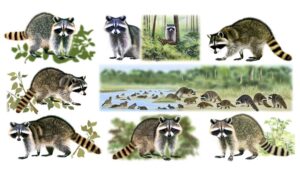How Do Raccoons Show Affection?
Raccoons display affection using a variety of social and physical behaviors. These include grooming each other, gentle nuzzling, and sharing food, which foster social bonding.
Playful wrestling and soft purring are observed during physical interactions. Vocalizations, such as chirping sounds, accompany their affectionate gestures.
Additionally, raccoons maintain social cohesion by staying close, following one another, and licking faces. These interactions are crucial for group dynamics and social structure.
To gain a deeper understanding, further examination of these behaviors is necessary.

Key Takeaways
- Raccoons groom each other to maintain hygiene and reinforce social bonds.
- They engage in playful wrestling to develop social skills and hierarchy.
- Gentle nuzzling is used to provide comfort and strengthen social structures.
- Sharing food helps raccoons to strengthen familial bonds and cooperative interactions.
- Chirping sounds are used to express affection and maintain social structures.
Grooming Each Other
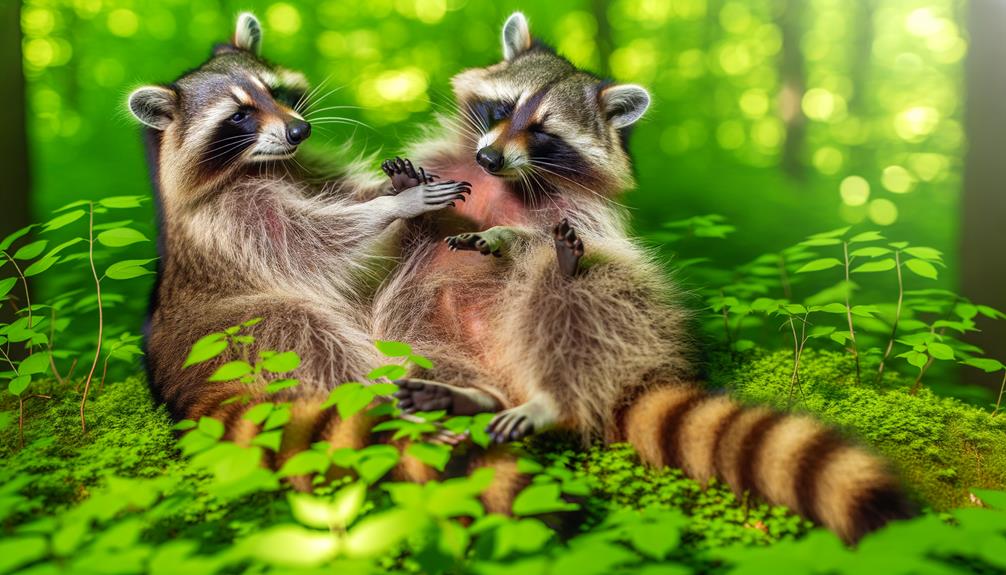
Grooming behaviors in raccoons (Procyon lotor) serve as a critical mechanism for social bonding and maintenance of hygiene within the group. These behaviors involve meticulous cleaning of fur, targeting parasites, and removing debris, consequently promoting overall health.
Observations indicate that grooming often occurs between individuals with pre-established social bonds, such as kin or close associates. This activity not only enhances physical cleanliness but also reinforces social cohesion and hierarchy within the group.
Mutual grooming sessions typically involve the use of dexterous forepaws and oral grooming, demonstrating the raccoons' adaptability and fine motor skills. By engaging in these practices, raccoons mitigate potential health risks and fortify their social structures, thereby ensuring group stability and cooperative interactions.
Playful Wrestling
Playful wrestling among raccoons, characterized by physical interactions such as tumbling, grappling, and mock biting, serves as a vital behavior for social development and the establishment of hierarchical relationships within the group. This activity, often observed in juvenile raccoons, facilitates motor skill enhancement and strength building.
Additionally, it provides an essential medium for learning social cues and boundaries, which are pivotal in mitigating future conflicts. The intensity and frequency of these wrestling bouts can indicate the strength of social bonds and the level of trust among individuals. Observational studies suggest that such interactions are not merely recreational but play a significant role in the cognitive and emotional development of raccoons, thereby reinforcing group cohesion.
Gentle Nuzzling
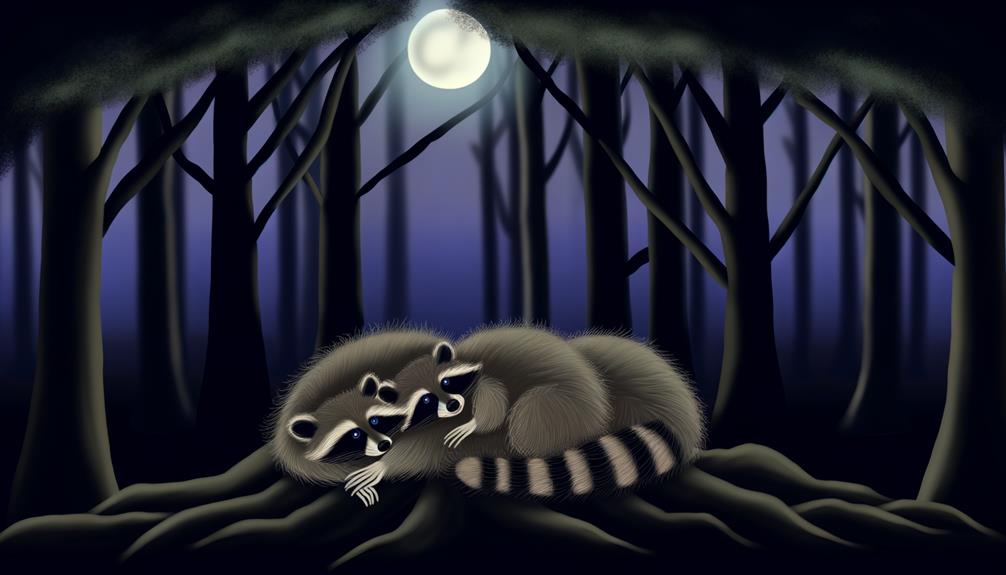
Raccoons exhibit gentle nuzzling behaviors characterized by facial rubs, soft touches, and maintaining close proximity to one another. These actions suggest a form of social bonding and comfort, as observed in their interactions.
Such behaviors may indicate a significant aspect of their social structure and emotional expression.
Facial Rubs
Facial rubs, characterized by gentle nuzzling behaviors, serve as a significant mode of social bonding among raccoons. This behavior involves the raccoon using its face to softly rub against another individual, facilitating the exchange of scents and reinforcing social structures within their group. Through detailed ethological studies, it has been observed that facial rubs are mainly exhibited among familial units and close associates.
| Observation | Frequency | Context |
|---|---|---|
| Parent-Offspring | High | Comfort and reassurance |
| Sibling Interaction | Moderate | Playful bonding |
| Mating Pairs | Low | Courtship behavior |
| Social Groups | Variable | Group cohesion |
Such interactions are essential for maintaining social harmony and ensuring the collective well-being of raccoon communities.
Soft Touches
Gentle nuzzling, characterized by soft touches using paws and snouts, plays an important role in raccoon social interactions by fostering close bonds and reducing stress within groups.
Observational studies indicate that raccoons employ these gentle tactile behaviors to communicate affection and reassurance among conspecifics. This behavior is often observed between mothers and their offspring, as well as among adult raccoons in social groups.
The act of nuzzling appears to release endorphins, promoting a sense of well-being and relaxation. Additionally, these soft touches can serve as a non-verbal form of communication, conveying trust and solidarity.
Through consistent gentle nuzzling, raccoons reinforce social hierarchies and facilitate group cohesion, essential for their survival and social stability.
Close Proximity
Within the context of raccoon social behavior, close physical proximity during nuzzling interactions serves as an essential mechanism for maintaining social bonds and establishing trust. Observations indicate that this behavior is multifaceted, encompassing several elements vital for social cohesion.
- Gentle Nuzzling: Raccoons engage in soft, repetitive movements using their snouts to nuzzle each other, which reinforces social bonds.
- Mutual Grooming: This often accompanies nuzzling and serves to remove parasites, providing both hygienic and social benefits.
- Vocalizations: Soft purring or cooing sounds often accompany nuzzling, further indicating comfort and contentment.
- Body Language: Relaxed postures and slow movements signify a non-threatening interaction, essential for trust-building.
These behaviors collectively establish and reinforce the raccoons' intricate social structures.
Sharing Food
Observations suggest that raccoons often display food-sharing behaviors, which may imply a social structure that includes cooperative interactions. Such behaviors are mainly observed in familial groups, where adult raccoons provide food to their offspring. This act not only secures the survival of the young but also strengthens social bonds within the group.
Additionally, raccoons have been noted to share food resources during periods of scarcity, potentially indicating a form of reciprocal altruism. This behavior is typically characterized by the voluntary transfer of food items without immediate returns, implying a level of trust and cooperation.
The sharing of food among raccoons may serve as an indicator of intricate social dynamics, enhancing group cohesion and overall adaptive success.
Chirping Sounds
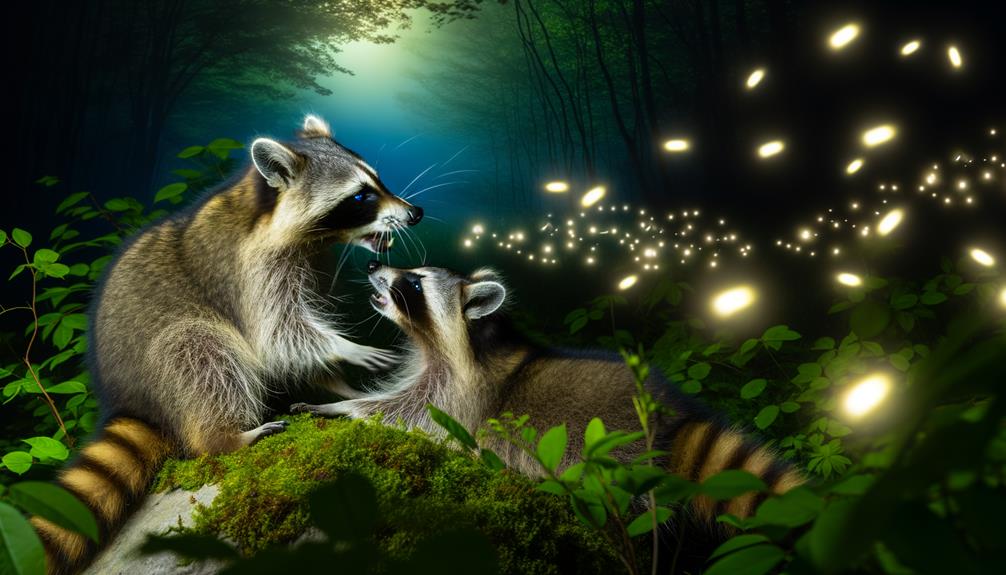
Audible vocalizations, especially chirping sounds, are a significant aspect of raccoon communication, often serving as a way to express affection and strengthen social bonds within their groups. These vocalizations exhibit several distinct characteristics:
- Frequency Modulation: Chirping sounds vary in pitch and frequency, which can indicate different emotional states or intentions.
- Contextual Usage: Raccoons use chirping mainly in social contexts, such as grooming or close proximity interactions.
- Developmental Significance: Juvenile raccoons produce chirping sounds more frequently, suggesting a role in parental bonding and dependency signaling.
- Acoustic Distinction: Each raccoon may have unique chirp patterns, enabling individual recognition and fostering stronger social cohesion.
These auditory signals play an important role in maintaining the complex social structures of raccoon communities.
Tail Wagging
Tail wagging in raccoons serves as a non-verbal communication method that conveys a range of emotional states and social intentions. Observations indicate that raccoons utilize tail movements as a form of social signaling among conspecifics.
A gentle, rhythmic wagging often signifies contentment and amicability, particularly in social interactions or bonding activities. Conversely, rapid or erratic tail movements can indicate agitation or alertness, suggesting a heightened state of arousal.
These tail behaviors are integral to understanding raccoon social dynamics, as they provide insights into the animal's emotional and psychological state. The specificity of these movements underscores their importance in raccoon communication, offering a nuanced medium through which these animals express complex social cues and establish social cohesion.
Gentle Nibbling
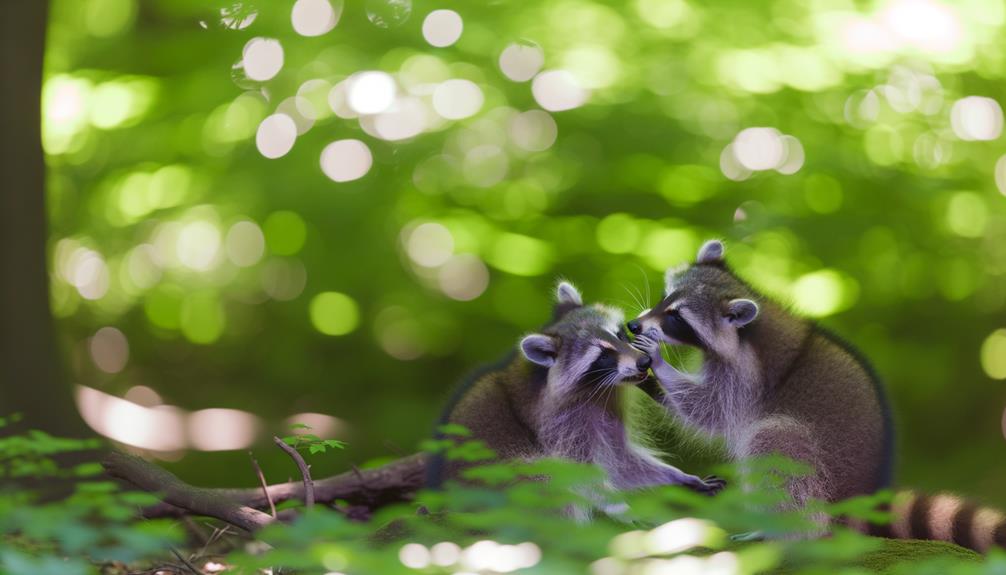
Gentle nibbling in raccoons is a behavior often associated with social bonding and affectionate interactions among individuals. This nuanced behavior has been observed to serve multiple functions within raccoon communities:
- Grooming: Gentle nibbling can aid in the removal of parasites and debris from the fur, promoting overall hygiene.
- Social Hierarchy: This behavior can reinforce social structures, with dominant individuals gently nibbling subordinates to establish and maintain social order.
- Mating Rituals: During courtship, gentle nibbling may serve as a prelude to mating, indicating interest and reducing aggression.
- Parental Care: Mothers often gently nibble their young to encourage grooming and comfort, fostering a bond between the parent and offspring.
These observations highlight the multifaceted role of gentle nibbling in raccoon social dynamics.
Staying Close
In addition, raccoon social interactions play a critical role in maintaining group cohesion and individual well-being. Observations indicate that raccoons demonstrate affection through spatial closeness, often engaging in behaviors such as sitting or lying adjacent to one another. This physical nearness fosters a sense of security and strengthens social bonds within the group.
Moreover, raccoons are known to participate in communal grooming and resting activities, which not only serve practical purposes but also reinforce social ties. The propensity for raccoons to remain in close physical quarters with their kin and peers is indicative of their complex social structure.
Licking Faces

One of the most notable behaviors raccoons exhibit to show affection is face-licking, a practice that facilitates social bonding and reinforces group cohesion. This behavior is observed primarily in familial and close social groups, serving multiple functions:
- Hygiene Maintenance: Regular licking helps in cleaning each other's fur and skin, reducing parasite load.
- Olfactory Communication: Raccoons use scent markers in saliva to convey information about identity and reproductive status.
- Stress Reduction: Physical contact through face-licking lowers stress hormones, promoting relaxation and trust.
- Social Hierarchy: This behavior can also help establish social hierarchies within the group, as dominant individuals may receive more grooming.
These interactions underscore the complexity of raccoon social structures and their methods of non-verbal communication.
Soft Purring
Soft purring in raccoons is a vocalization typically observed during close social interactions, indicative of contentment and affection within the group. This low-pitched sound is produced by the vibration of the vocal cords and is most commonly heard during grooming sessions or while resting in close proximity to one another. The purring serves as an auditory signal that reinforces social bonds and reduces tension among group members. Importantly, this behavior is also seen between mothers and their offspring, highlighting its role in nurturing and familial cohesion.
| Observation | Description |
|---|---|
| Pitch | Low-pitched sound |
| Occurrence | During grooming, resting, close social interaction |
| Social Context | Reinforces bonds, reduces tension |
| Maternal Behavior | Common between mothers and offspring |
Such vocalizations underscore the complex social dynamics within raccoon groups.
Following Around
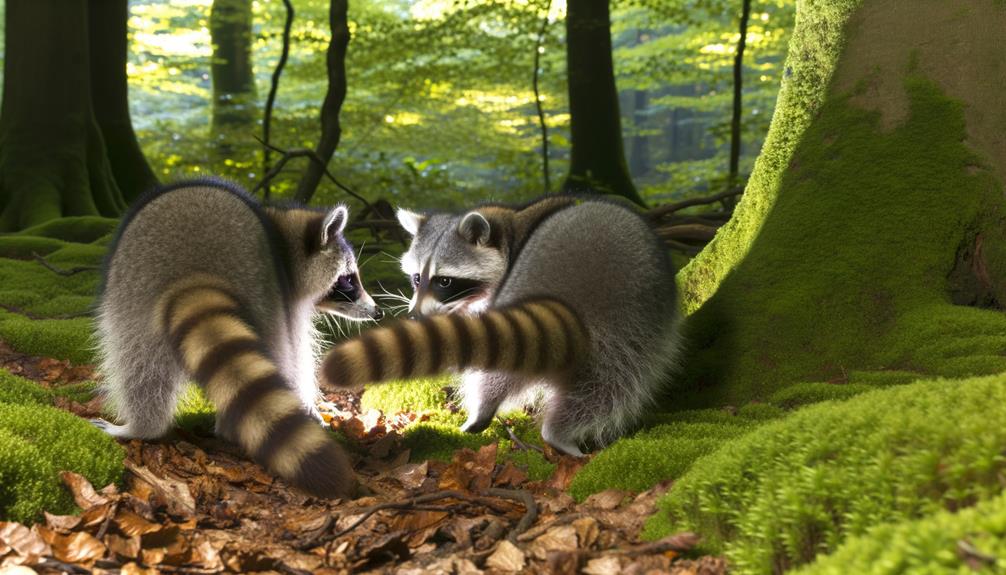
Following behavior in raccoons is frequently observed and is indicative of their social and affectionate tendencies.
This behavior includes mimicking human activities, seeking physical proximity, and emitting soft vocalizations.
Such actions suggest raccoons actively pursue interaction and maintain close bonds with their human counterparts.
Mimicking Human Behavior
Raccoons, through their unique propensity to follow humans, exhibit behaviors that suggest a capability for complex social interactions and environmental adaptability. This mimicking of human behavior is not merely coincidental but indicative of their advanced cognitive functions. Observational data reveal several key aspects:
- Proximity Maintenance: Raccoons often stay within a close range of humans, mirroring social attachment behaviors seen in domesticated animals.
- Behavioral Synchrony: These animals tend to imitate activities such as opening containers or handling objects, showcasing their learning capabilities.
- Exploratory Actions: Following humans can lead raccoons to new resources and environments, demonstrating adaptive learning.
- Communication Signals: By shadowing human movements, raccoons may be attempting to engage in non-verbal communication, indicating social intelligence.
These behaviors underline their sophisticated interaction mechanisms.
Seeking Physical Contact
Engaging in behaviors indicative of seeking physical contact, Procyon lotor exhibits a notable propensity for following humans closely, suggesting an underlying desire for tactile interaction. This behavior is often observed in domesticated or habituated individuals who have formed bonds with humans.
The raccoon's tendency to shadow its human counterparts is not merely a quest for food but also an indication of social attachment. Detailed observations reveal that these animals frequently attempt to initiate physical contact through gentle nudges or by climbing onto the person being followed.
Such actions underscore their complex social structures and ability to form interspecies relationships. The raccoon's pursuit behavior is a key identifier of its affectionate tendencies, highlighting the species' nuanced social dynamics.
Vocalizing Softly
While trailing their human companions, raccoons often emit soft vocalizations, a behavior that signifies their desire for interaction and serves as a communication method within their social framework. These subtle sounds, which can include purring, chittering, and cooing, provide insight into raccoons' complex social behaviors and affinity for human interaction. Scientific observations indicate that these vocalizations serve several functions:
- Bonding: Strengthens the emotional connection between raccoons and their human caretakers.
- Attention-seeking: Signals a raccoon's immediate need for attention or resources.
- Comfort Expression: Indicates a raccoon's comfort and contentment in the presence of humans.
- Interactive Cue: Encourages reciprocal interaction and engagement from humans.
These behaviors underscore the raccoon's capacity for nuanced social communication.
Conclusion
To sum up, raccoons exhibit a plethora of affectionate behaviors that underscore their social complexity. Through grooming, playful wrestling, gentle nuzzling, and food sharing, they demonstrate intricate social bonds.
The subtlety of chirping sounds, staying close, face licking, soft purring, and following behaviors further accentuates their deep emotional connections.
These actions collectively reveal a depth of affection that is nothing short of extraordinary, akin to a Shakespearean sonnet of the animal kingdom, highlighting raccoons' nuanced and dynamic social interactions.



